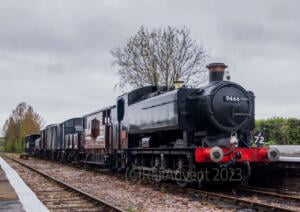The Rail Accident Investigation Branch (RAIB) has issued its report when two trains were in the same signal section at South Wingfield in Derbyshire last October.
The incident occurred at about 07:02 on 26 October 2022, when a signal unexpectedly displayed a red aspect ahead of a train travelling between Derby and Chesterfield.
The previous signal had displayed a green aspect, but as the train was travelling at 100 mph it could not stop before it reached the red signal and overran it by about 760 metres.

The train driver immediately called the signaller to report the incident, but about 17 minutes later, another train approached the signal, which was then displaying a yellow aspect.
After passing the signal, the train was travelling at about 20 mph when its driver saw the taillights of the first train stationary ahead of it.
The driver braked and came to a controlled stop about 75 metres from the rear of the first train, resulting in both trains being in the same signal section, but with no significant consequences.
After obtaining permission from the signaller, both trains were allowed to continue their journeys.

The reason for the incorrect signal aspects was the wiring controlling the signals red and yellow aspects had been incorrectly connected in a nearby equipment cabinet, from where a cable to the signal was connected to the rest of the signalling system.
That cable had been disconnected and reconnected during track engineering work the previous night and had not been identified when the signal was tested afterwards.

area (top right), and closeup of signal DY586 greyed out on the workstation display. // Credit: RAIB
Testing of the signal had been adversely affected by a combination of time pressure, tester workload, and possibly because the tested was unfamiliar with the configuration of the signalling equipment.
An underlying factor was that although Network Rail had taken steps to make sure that signal maintenance testing carried out by its own staff was up to standard, it had not yet included such assurance for testers employed by contractors.
A second underlying factor was that no individual had been assigned to perform any signalling-related assurance activities when that particular type of track engineering work was taking place.
RAIB noted that actions taken by the signallers at East Midlands Control Centre and by the second train driver reduced the potential for a collision between the two trains. It also noted that there are four issues with the testing work covering:
- test records;
- tester licensing;
- deficiencies with drawings;
- omission of tests the previous night.
It also noted that although both drivers underwent initial welfare checks, only one of the drivers was underwent follow-up post-incident welfare checks.
As a result of the investigation, RAIB has made five recommendations.
- 1. and 2. Bridgeway Consulting and Randstad Solutions should enhance the non-technical skills among their staff, specifically effective communication, safe decision-making, and safe behaviours when placed under time pressure.
- 3. Network Rail should improve the management of the workload on lead testers.
- 4. Network Rail should implement measures to improve its assurance that signal maintenance testing by contractors on this type of track engineering work is to the required standard.
- 5. Network Rail should provide testers with a method to record the test steps taken when a signal s aspects are tested.
RAIB also identified six learning points.
- 1. The importance that signal maintenance testers should follow the required testing process.
- 2. Staff working in management or supervisory roles should not place testers under undue time pressure to complete their work, even when they themselves are under time pressure due to overrunning work.
- 3. and 4. The importance of communication between signallers and train drivers when an incident occurs.
- 5. Signalling equipment, particularly track circuits, must be tested, after engineering work has taken place on the track
- 6. Follow-up post-incident checks must be carried out with all drivers involved in a signalling irregularity.
Andrew Hall, Chief Inspector of Rail Accidents said: “The incident at Wingfield has echoes of the tragic accident at Clapham Junction nearly 35 years ago. Even more worryingly perhaps, it also has echoes of a more recent collision at Waterloo in 2017 and a derailment at Dalwhinnie in 2021.
“All these events involved a signal that should have been displaying a red aspect to protect against an unsafe situation but was not doing so. In each case, this was due to a fault being introduced in the signalling system’s wiring and then not being detected by testing, after work on the system had been undertaken.
“The railway implemented very significant changes to processes around the installation, maintenance and testing of signalling systems after the accident at Clapham. The importance of following these established processes to maintain the safety integrity of the signalling system, and the potential for unsafe events to occur when they are not followed, is once again shown by the events at Wingfield.”
“Some in the railway industry will remember the accident at Clapham; some will not. It is natural that in the aftermath of such a large-scale accident, the importance of following the improved processes that resulted from it would be well and widely understood. The passage of time may tend to diminish that understanding, but three events with similar causes in the last six years shows that it cannot be allowed to do so.”






Responses